|
1.
CENTRAL AND WEST AFRICA
Power outages disrupting production
The timber industry in Gabon is under severe pressure due
to widespread disruptions in energy supply, particularly in
special economic zones. These disruptions are said to be
linked to financial difficulties within the SEEG power
company which is partly owned by the British firm
Aggreko.
The reported power company debt of 15 billion FCFA to
Aggreko has led to a suspension of the electricity supply
severely hampering production and resulting in worker
layoffs. Although SEEG has recently managed to secure
funds from Bank BFI to address the debt, ongoing issues
such as the prolonged repair of turbines and insufficient
water levels in the Kinguélé Dam are causes for concern in
Gabon.
See:https://www.lenouveaugabon.com/fr/energies/2108-20408-
electricite-aggreko-menace-darreter-ses-centrales-a-cause-de-15-
milliards-fcfa-des-factures-impayees-par-la-seeg
Intensified oversight of forest operations
The government has intensified its oversight of forestry
operations, particularly focusing on companies failing to
comply with the Community Contribution Commitment
(CCC) and land tax obligations.
The CCC mandates that operators share production figures
and contribute 800 FCFA per cubic metre of timber
harvested with local communities and regional
administrations.
Non-compliance with these regulations is met with strict
penalties, including the cancellation of logging
concessions. Some say enforcement at this time is driven
by political motivations ahead of the upcoming
presidential elections.
Observations on the market
Operators report timber markets are giving mixed signals.
The market for sawn azobe remains robust with steady
demand from Dutch buyers for garden squares, waterways
and dragline mats/sheets these mats provide a stable
surface for heavy machinery to move on. Most pieces
measure 20 x 20 cm and range from 5 to 7 m in length.
Conversely, the market for lower density timbers,
particularly okoume and ayous, is experiencing sluggish
demand with China making small purchases at low prices.
Producers in Cameroon are said to have an advantage as
they can offer more competitive prices than Gabon and
Congo as export duties are lower.
Producers cautiously optimistic on demand prospects
Weather conditions are impacting operations with heavy
rains affecting production in the Cameroon and the rain
season has started in Gabon and Congo. The rains make it
difficult to maintain log stocks and production schedules
tend to slide.
Producers in the region say price levels are expected to
remain stable in the near term, influenced by the end of the
holiday season in Europe and ongoing demand
fluctuations in key markets such as China, the Philippines
and the Middle East.
The industry remains cautiously optimistic though the
potential for further disruptions and the impact of stringent
regulatory enforcement needs to be closely monitored.
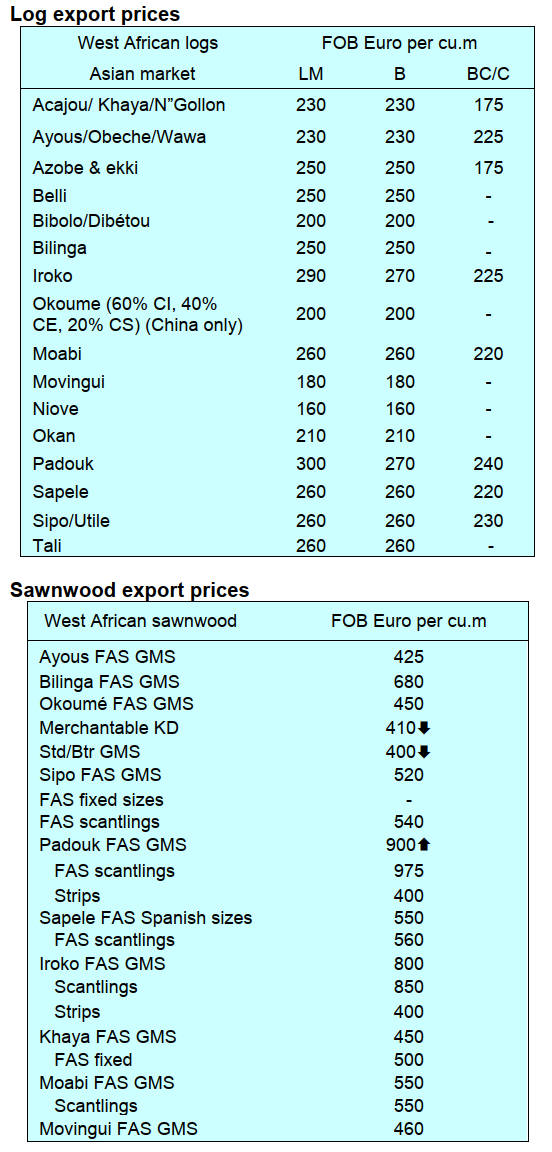
2.
GHANA
Overall exports dip but positive growths for
some
products
Data from the Timber Industry Development Division
(TIDD) of the Forestry Commission indicates that wood
product exports in the first half year of this year were
133,126 cu.m. In the same period in 2023 the volume was
155,422 cu.m, indicating a 14% year on year decline in
2024.
For the same period, total receipts from wood product
exports were Eur60.58 million compared to the Eur70.53
million in the first half of 2023, a 14% drop.
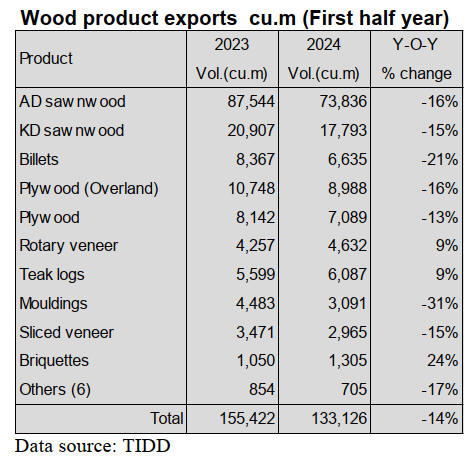
The decline in export volumes is partly a reflection of
insufficient raw materials high production costs and weak
international demand. As production and shipping costs
rise millers lose the incentive to boost production.
In spite of the overall decline in export volumes and
values for the half year exports of briquettes, teak logs and
rotary cut veneer registered volume increases of 24%, 9%
and 9% respectively in the current half year compared to
2023.
Revenue generated from these three products also
recorded corresponding positive growth during the period
in 2024 against the same period in 2023 as shown in graph
below;
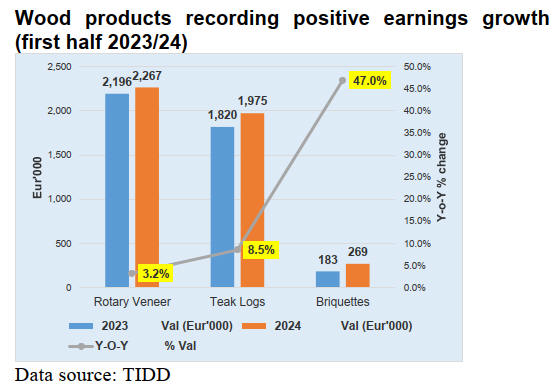
Of the 16 products exported during the period sawnwood
(91,629 cu.m), veneers (7,597 cu.m) and plywood (16,077
cu.m) together accounted for 87% of total export volumes.
Ghana Shipping - New law to replace the 50 year old
legislation
Parliament has passed the Ghana Shippers Authority Bill,
2024, into Law to replace the 50 year old NRCD 254
(1974) Legislation. The new law seeks to regulate the
commercial activities of shippers and also to address the
issue of unfair and excessive charges that burden
importers and exporters who use Ghana’s sea, air and land
frontiers.
The new law aims to introduce transparency in the
determination of port fees and charges to ensure that there
is accountability in the legal movement of international
trade cargo across all of borders of Ghana. Additionally, it
is also to make Ghana a preferred transit trade channel for
her landlocked neighbours of Burkina Faso, Mali and
Niger and to enhance the sector’s revenue collection.
The Law empowers the Ghana Shippers Authority (GSA)
to better adapt to emerging trends and complexities within
the shipping and logistics industry. It will also protect the
interests of shippers and shipping service providers and
improve the GSA regulatory oversight of the entire
industry. The Chief Executive Officer of GSA, Kwesi
Baffour Sarpon, expressed optimism saying the passing of
the law is a huge step in the right direction and the
enforcement of the law will be fair and representative of
the interests of the shipping industry.
The Ghana Union of Traders Association (GUTA) has
welcomed the newly passed GSA Law saying it will offer
the Authority “the teeth” to effectively regulate the
shipping industry to approve or disapprove import charges
that affect the general cost of doing business in the
country.
See: https://shippers.org.gh/index.php/parliament-passes-
shippers-authority-bill-into-law/
FORM Ghana agreement with Climate Impact Partners
on carbon credits
FORM Ghana Limited has signed an agreement with
Climate Impact Partners, a carbon finance organisation, to
provide exclusive access to 371,000 high-quality carbon
credits from a reforestation project in two locations in
Central Ghana.The project aims to reforest 20,000 hectares
of degraded forest reserves in Ghana. Plantation species
for the project includes teak and some native species.
The pres release says the project has created more than
1000 jobs, with 40% of women participation in a
community impacted by climate change. The project is
expected to promote land management practices that help
to enhance food security.
See: https://www.climateimpact.com/news-insights/news/form-
ghana-and-climate-impact-partners-announce-exclusive-
agreement-on-400000-carbon-removal-credits/
Non-traditional exports almost US$4 bil. in 2023
The Ghana Export Promotion Authority (GEPA) has
reported a remarkable doubling of Non-Traditional
Exports (NTEs) earnings in 2023 which reached almost
US$4 billion a marked increase from the US$3.5 billion
recorded in 2022.
The driving force behind this expansion was the rise in
exports closely linked to improved performance in the
manufactures/semi-processed products and crafts
(handicrafts) sectors.
The growth could also be attributed to a combination of
structural changes within Ghana’s NTEs framework and
the successful implementation of the National Export
Development Strategy (NEDS).
According to the GEPA report during the period 1,702
companies were engaged in exporting 625 non-traditional
products to 156 countries. Notably, the earnings from 88
exporting companies contributed 80% of the total non-
traditional exports for the year under review.
Burkina Faso emerged as the top market destination for
Non-Traditional Exports (NTEs), accounting for 20% of
NTEs. The Netherlands followed closely, absorbing 15%
of NTEs.
ECOWAS countries, including Togo, Cote D’Ivoire and
Mali, made up 30% of the top ten market destinations for
NTEs. The remaining market shares were distributed
among North America (10%), India (8%), Italy (6%),
Belgium (6%) and the United Kingdom (6%).
To enhance exports, the Ghana Export Promotion
Authority (GEPA) has embarked on several initiatives,
including market research, export promotion campaigns
and capacity building for exporters.
See: https://www.gepaghana.org/export-statistic/non-traditional-
export-statistics-2023-report/
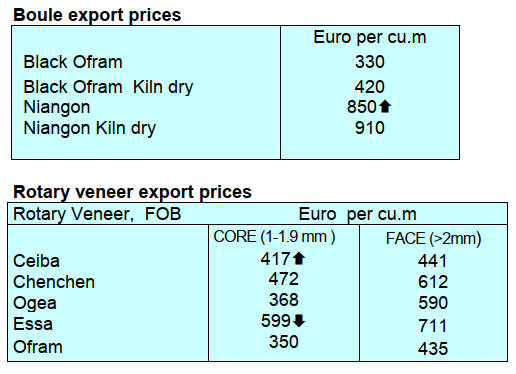

3. MALAYSIA
Solid second quarter GDP growth
Bank Negara Malaysia announced that the country’s
economy advanced by 5.9% year on year in the second
quarter of 2024. This growth was fuelled by increased
domestic demand and expansion of exports.
The Bank Governor said growth in investment reflected
robust capacity expansion by businesses as well as
continued targeted spending by government and public
corporations, adding, “the net export registered a positive
turnaround due to the stronger export recovery and higher
external demand and a global technology upcycle”.
In August the Malaysian currency strengthened to 18-
month highs against the US dollar as the U.S. Federal
Reserve contemplates a rate cut.
The Malaysian ringgit was the best-performing Asian
currency, up 5.3% for the year in mid August trading at
4.361 per dollar its highest point since February 2023. The
currency's strength is a reversal from February when
it dropped to its weakest in 26 years.
See: https://asia.nikkei.com/Economy/Malaysia-GDP-growth-
accelerates-to-5.9-in-Q2
Sabah TLAS - aligning with the EUDR
The Sabah Timber Legality Assurance System (TLAS) is
the due diligence system designed to ensure that timber
products from Sabah are manufactured from wood raw
materials harvested, processed and traded in strict
compliance with local laws and international standards.
Since 2007 Sabah has been actively participating in the
EU negotiations regarding the Forest Law Enforcement,
Governance and Trade (FLEGT) and the Voluntary
Partnership Agreement (VPA) for Malaysia.
The Sabah TLAS was developed and endorsed in 2009 in
response to growing international concerns regarding the
high-risk trade in tropical timber and to meet EU
requirements under the FLEGT programme.
The Sabah TLAS encompasses six principles and 20
criteria covering 65 upstream companies, including 43
Sustainable Forest Management License Agreements
(SFMLA) holders and 156 downstream mill and trader
companies.
Over the past decade, the Sabah TLAS has been
strengthened through stakeholder consultations and
Implementing Agencies Coordination Committee (IACC)
meetings to enhance compliance, transparency, and forest
governance.
In June 2024, the Sabah Forestry Department collaborated
with the EU to update the Sabah TLAS aligning with the
EUDR incorporating key certification elements such as
sustainability, environmental protection and social
responsibility.
See:
https://theborneopost.pressreader.com/article/281629605568196
Plantations ensure the sustainable supply of timber
Deputy Plantation and Commodities Minister, Chan Foong
Hin, concluded a working visit to Keningau in Sabah
where he underscored the critical role of forestry
plantations in ensuring the sustainable supply of timber to
Malaysia’s wood industry.
The Deputy Minister’s visit to the Sapulut Forest Reserve
was to observe sustainable forest management practices.
The Reserve is recognised locally as a leading example of
industrial tree plantation efforts in Sabah.
See:
http://theborneopost.pressreader.com/article/281612425722876
Sarawak / Australia collaboration
The Sarawak government, represented by the Forest
Department Sarawak (FDS), signed a letter of intent
(LOI) with the University of the Sunshine Coast (UniSC)
aimed at building bilateral collaboration in forestry
research, capacity building and technology transfer.
Prior to the LOI signing the Sarawak delegation was
briefed with research presentations by four lecturers and
researchers of UniSC and Forest Research Institute on the
topics including ‘Breeding and Silviculture to Improve
Plantation Productivity and Value’ as well as ‘Pest
Management in Plantation Forests in Borneo’.
See:
https://theborneopost.pressreader.com/article/281578065979482
Furniture Design Competition
The MIFF Furniture Design Competition celebrates the
creative spirit of design and to uncover young talent to
support Malaysia’s thriving furniture industry. Organised
each year since 2010 in conjunction with Malaysian
International Furniture Fair (MIFF), it offers the best
platform for emerging designers to showcase their
innovative ideas.
See: https://www.mifffdc.com/about/?cid=edm140825ebriefing
4.
INDONESIA
Furniture sector secures sales in India
The Ministry of Industry has reported that domestic
furniture makers did well at the 2024 IndexPlus Delhi
Exhibition securing Rp17 billion in orders. Ignatius
Warsito from the Ministry remarked that India is a
promising market for Indonesia furniture makers. Adding,
based on IndexPlus data the Indian consumer market has
the potential to be the third-largest in the world by 2027.
Furthermore, the percentage of the Indian population
living in urban areas is increasing and this creates a
potential market for furniture of US$40 billion.
"We hope the large market potential and dynamic furniture
market trends can be utilised by the furniture sector,
including furniture designers, who play a major role in
realising marketable furniture design trends" he remarked.
See: https://www.neraca.co.id/article/203905/industri-furnitur-
bukukan-nilai-komitmen-rp17-miliar-di-india
In related news, the chairman of the Indonesian Furniture
and Craft Industry Association (HIMKI), Abdul Sobur,
estimates that the export market will grow 5-8% this year
with the domestic market growing 4-6%. Expansion will
be supported by the government's initiative to boost the
furniture industry, including the programme to restructure
machinery and equipment for the wood processing
industry.
The restructuring programme aims to improve
competitiveness and also support the growth of upstream
industries. The chairman of the Indonesian Sawmill and
Woodworking Association (ISWA), Wiradadi
Soeprayogo, stated that there has been a surge in furniture
demand both domestically and in the international market
and Indonesia can position iself as a strategic exporter.
See: https://m.antaranews.com/amp/berita/4275899/himki-
perkirakan-pasar-ekspor-industri-mebel-tumbuh-8-persen
Indonesia targets 11 million ha. of plantations
The Ministry of Environment and Forestry (KLHK),
through the Environmental and Forestry Instrument
Standardisation Agency (BSILHK), is preparing Standards
for calculating emission reductions by Industrial
Plantation Forests (HTI) as part of efforts to mitigate
climate change.
The Head of BSILHK, Ary Sudijanto, said that the
development of industrial plantations is not only to meet
the demand for roundwood for the timber industry but also
to fulfill the Long-Term Strategy for a Low Carbon
Scenario compatible with Paris Agreement (LTS-LCCP)
and the NDC aims.
Ary stated that the target for the development of plantation
forests in Indonesia by 2030 is 11.227 million hectares.
This will significantly contribute to achieving the
'Indonesia's FOLU Net Sink 2030' target and
implementing the President's mandate through Presidential
Decree 98/2021 concerning the Implementation of Carbon
Economic Value (NEK).
See:
https://lestari.kompas.com/read/2024/08/12/162610986/klhk-
hutan-tanaman-industri-disiapkan-sebagai-pengurang-emisi-
karbon.
Geo-spatial data to determine forest areas
The Indonesian government, through the Ministry of
Environment and Forestry (KLHK), is actively working to
finalise the process of determining forest areas. This is
being done to establish legal certainty regarding the status,
location, boundaries, and extent of forest areas. It is also
aimed at preventing forestry crimes such as encroachment,
illegal logging and unauthorised occupation.
The Directorate General of Forestry Planning and
Environmental Management (Ditjen PKTL) in the
Ministry plays a strategic role in accelerating the
determination of the legal status of forest areas.
The Director of Forest Area Establishment and
Management (PPKH), Donny August Satria Yudha,
revealed that the Ministry is committed to accurately
demarcating forested area saying;
“We have completed the boundary marking and as of July
2024 106.5 million hectares of forested areas have been
determined. Currently, we are in the process of correcting
documents for the remaining 16% to ensure proper
administrative order and prevent any future discrepancies."
To monitor forest areas, the Directorate General of PKTL
uses geo-spatial data. Erik Teguh Primiantoro, Director of
Forest Resources Inventory and Monitoring, mentioned
that the Ministry of Environment and Forestry has
introduced the National Forest Monitoring System
(SIMONTANA) and the Ministry of Environment and
Forestry Geospatial Information System (SIGAP KLHK).
See: https://news.detik.com/berita/d-7494236/klhk-manfaatkan-
data-geospasial-dalam-penetapan-kawasan-hutan-di-ri.
Boosting downstream sector
The Minister of Environment and Forestry, Siti Nurbaya,
has called for boosting the downstream sector, including
marketing to support products from Social Forestry areas
which cover more than 8 million hectares. According to
Siti, access to 8.08 million hectares was given to 1.3
million heads of families.
Siti also emphasised the expansion of markets for primary
forest products through the Forest Product Processing
Business License (PBPHH) utilising community wood as
raw material. She mentioned that the programme had
established community forests to ensure the continuous
availability of raw materials through collaboration with the
community.
See: https://wartaekonomi.co.id/read542086/produk-perhutanan-
sosial-perlu-digenjot-hilirisasi-begini-kata-menterinya-jokowi
In related news, the steadily increasing value of economic
transactions involving forest farmer groups (KTH) has
been driving growth of regional economies according to
Minister Siti Nurbaya Bakar. She highlighted that the total
value of KTH economic transactions jumped from Rp448
billion (US$28.5 million) in 2022 to Rp730 billion
(US$46.4 million) in 2023. As of July 2024, as many as
4,736 KTHs have made economic transactions worth
Rp535 billion (US$34 million).
She added, KTH activities have contributed not only to the
finances of the farmers but also to the growth of regional
economies through the forestry sub-sector. She noted that
the positive trend has been the result of the schemes and
programmes implemented by her ministry.
She highlighted the vital role played by forestry extension
workers in empowering and guiding people at the
grassroots level in managing forest areas and business
development.
Furthermore, she underscored that the economic
performance of KTH is a manifestation of people's
genuine participation in environmental and forestry
development efforts in Indonesia which she believes have
intensified in recent years.
See: https://en.antaranews.com/news/322559/forest-farmers-
playing-vital-role-in-boosting-local-economies-govt
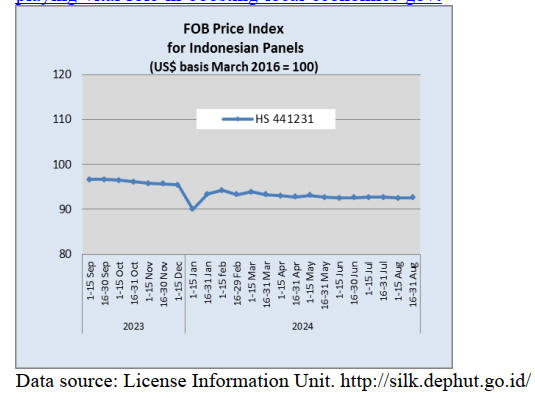
5.
MYANMAR
Merchants seek review of mandatory FX
conversion
poicy
The Central Bank of Myanmar (CBM) has reduced the
mandatory conversion of foreign currency export earnings
into the kyat (MMK) from 35% to 25%. This policy,
initially introduced in August 2022, required exporters to
convert 65% of their earnings into MMK. The local media
says, despite these reductions merchants argue that being
forced to convert at rates far below the market value
remains should be reviewed.
Myanmar's ongoing currency crisis, exacerbated by this
policy, is reportedly providing the military authorities with
significant income from controlling foreign currency
exchange rates.
An analysis reported by the press estimates that the gap
between market and enforced conversion rates could have
earned the regime up to 6.4 trillion kyats (US$1.8 billion)
by June 2023. This gap stems from forcing businesses to
convert their foreign currency at rates that overvalue the
kyat, far exceeding other forms of government revenue.
Since 2021, the market rate for MMK has plummeted
from around 1,300 to around 6,000 per US dollar, while
the CBM’s official rate is 2,100 kyats per dollar. The
authorities regulation of forex rates has been viewed as
having led to significant economic distortions contributing
to a decline in economic activity and growth of the
informal economy.
See: https://www.irrawaddy.com/business/myanmar-central-
banks-latest-forex-conversion-move-fails-to-impress-traders.html
and
https://www.irrawaddy.com/news/burma/myanmars-junta-is-
funding-its-war-through-forex-scams-economists-say.html
Fuel importers struggling with payments due to Kyat
devaluation
The Central Bank of Myanmar announced that it would
inject US$100 million into the foreign exchange market to
support fuel importers struggling with payments due to the
ongoing devaluation of the kyat against the US dollar.
Since the military takeover in 2021, the kyat has plunged,
making it difficult for importers to secure fuel shipments.
Rising costs for cooking oil, rice and other essentials have
compounded the crisis as the kyat continues to depreciate.
See: https://www.pattayamail.com/thailandnews/myanmars-
central-bank-injects-100-million-us-dollar-to-aid-fuel-importers-
amid-currency-crisis-468927
Interest rate increased
The Central Bank of Myanmar (CBM) announced on 14
August 2024 that it has revised its interest rates to address
inflation, offer better deposit return and boost economic
growth by enhancing the bank loan capabilities. The new
interest rate on deposits will be 9% and interest rate on
loans will be 15%.
See: https://eng.mizzima.com/2024/08/18/12948
Authorities try to ‘capture’ more of overseas worker
remittances
Myanmar regime has intensified its scrutiny of labour
agencies in a bid to capture more from overseas workers'
remittances. Under the current regulations, both the
agency and the worker are required to sign an employment
contract in the presence of a labor ministry official before
going abroad. The contract requires workers to remit at
least 25% of their earnings via authorized channels. It also
states that non-compliance will result in a three-year ban
from working overseas on the expiration of their current
permit.
This move is part of the regime's broader strategy to
alleviate its foreign currency shortage, which has
contributed to rising economic instability but many
migrant workers are reluctant to use formal banking
channels to send their wages home due to the significant
gap between the authorised bank and market exchange
rates. The bank rate is set at 4,150 kyat per dollar while
the market rate is around 6,000 kyat to the dollar.
See: https://asia.nikkei.com/Spotlight/Myanmar-
Crisis/Myanmar-reins-in-employment-agencies-to-harvest-
remittances
6.
INDIA
Construction sector - developers
facing liquidity
issues
A report from real estate data provider Prop Equity says
that 2,000 new housing projects in India are being stalled
by administrative and financial hurdles. That amounts to
over 500,000 new dwellings. These building developments
are across 42 cities, with Delhi, Mumbai and Bengalaru
worst affected.
The causes of delay are cited as financial constraints faced
by developers, regulatory issues and problems in land
acquisition and obtaining necessary approvals. Added
problems include high levels of unsold housing inventory.
The construction sector is urging government to provide
financial support for developers facing liquidity issues, to
streamline regulatory processes and enforce project
timelines more strictly.
See: https://www.constructionworld.in/latest-construction-
news/real-estate-news/nearly-2000-housing-projects-stalled-in-
india/61017
Government urged to consider allowing more Chinese
investment
An annual report on the health of the Indian economy has
departed from previous editions and recommended
government to allow more foreign direct investment (FDI)
from China. There have been strict controls on Chinese
investment since 2020. The emphasis has since been on
developing trade but the July report by India's Chief
Economic Adviser, V. Anantha Nageswaran, recommends
a relaxation of the FDI rules.
"Choosing FDI as a strategy appears more advantageous
than relying on trade,” he said. "As the U.S. and Europe
shift their immediate sourcing away from China, it is more
effective to have Chinese companies invest in India and
then export the products to these markets rather than
importing from China, adding minimal value, and then re-
exporting them.”
See:
https://www.indiabudget.gov.in/economicsurvey/doc/echapter.pdf
and
https://asia.nikkei.com/Economy/India-economic-report-card-
triggers-debate-over-China-investment
Plywood manufacturer expanding plantations
One of India’s largest wood panel manufacturers is
expanding plantation operations to meet its raw material
requirements. The company has planted about 52,983
acres (21,441 hectares) with over 42 million saplings. The
target of its current programme is a total of 60,000 acres
by 2025. The plantations are in Nagaland, West Bengal,
Odisha and Gujarat.
The company has engaged Rain Forest Research Institute,
local communities and farmers to develop plantations of
eucalyptus, khokan (Duabanga grandiflora) and neem
(Azadirachta indica).
India’s Ministry of Defence has also announced a tree
planting project. At various MOD sites across India, along
with the Delhi Development Authority and other local
governments, it plans to plant 1.5 million saplings.
Source: https://www.plyreporter.com/
https://timesofindia.indiatimes.com/business/india-
business/greenply-gets-into-plantation-drive-to-ease-raw-
material-supply/articleshow/109504616.cms
and
https://www.mediaeyenews.com/news/announcement/mas
sive-tree-plantation-drive-to-be-launched-by-defence-
ministry-next-month-on-independence-day/126819.html
Estonian mission explores opportunities in India
Seven Estonian timber companies recently visited India on
a trade mission organised by Enterprise Estonia. Starting
in Kandla, Gujarat, one of India’s major timber port hubs,
the Estonian delegation interacted with owners of trading
houses and sawmills to identify potential business
opportunities and partners.
The group met with the Kandla Timber Association
representing over 2,000 timber-related businesses in the
region. Companies expressed a strong desire to collaborate
with Estonian businesses to help meet increasing demand
for high-quality wood products in India.
In Mumbai, the delegation met with architects, importers
and log house builders to discuss their timber
requirements.
Source: https://www.mediaeyenews.com/news
Climate change impacts Indian forest CO2 absorption
Global warming-induced weather changes are reducing the
CO2 absorption potential of India’s forests and their
capacity in turn to mitigate climate change say researchers.
According to studies by researchers at the Institute of
Technology in Bombay and Birla Institute of Technology
and Science, Goa, the key to the issue is the impact of
rising temperatures on photosynthesis.
Higher CO2 levels in the atmosphere can boost
photosynthesis but very high temperatures hinder enzymes
crucial for the process. The research found that in
northeast regions of India and the Western Ghats, despite
an increase in green cover from 2001-2019, there has been
a decrease in forest CO2 uptake.
See: https://pwonlyias.com/current-affairs/carbon-absorption-of-
indian-forest/


7.
VIETNAM
Wood and wood product (W&WP) trade
highlights
According to statistics from the General Department of
Customs, in July 2024 Vietnam’s wood and wood
products (W&WP) exports reached US$1.38 billion. That
was up 111% compared to June 2024 and up 23%
compared to July 2023. Of this, the wood product exports
contributed US$981.1 million, up 15% compared to June
2024 and30% compared to July 2023.
In the first seven months of 2024, W&WP exports were
US$8.9 billion, up 24% over the same period in 2023. Of
the total, wood products accounted for US$6.1 billion,
which was 24% ahead of the same period in 2023.
W&WP exports to Germany in July 2024 amounted to
US$4.3 million, up 25% compared to July 2023. In the
first seven months, they reached US$48.8 million, an
increase of 44% over the same period in 2023.
Exports of kitchen furniture in July were worth US$136
million, 37% up on July 2023. The first seven months total
reached US$787.4 million, an increase of 31% year on
year.
Vietnam's W&WP imports in July 2024 were worth
US$262.6 million, up 13% compared to June 2024 and
38% compared to July 2023. Imports in the first seven
months reached US$1.52 billion, up 24% on the same
period in 2023.
Vietnam imported 38,400 cu.m of oak in July 2024, worth
US$22.3 million. That was up 13% in volume and 13% in
value compared to June 2024 and 39% and 56%
respectively on July 2023. In the first seven months of the
year, oak imports reached 207,900 cu.m, worth US$119.7
million, up 27% in volume and 33% in value over the
same period in 2023.
Imports of raw wood (logs and lumber) from the US in
July 2024 reached 73,000 cu.m, with a value of US$31.5
million.
This was an increase of 11% in volume and 14% in value
compared to June 2024 and took the total of raw wood
imports from the US in the first 7 months to 394,290 cu.m,
at a value of US$169.14 million. Volume and value were
both up 29% on the same period in 2023.
Vietnam acts to boost timber sector
International market recovery resulted in the rise in
Vietnam’s timber export value in the year-to-date 2024.
However, the sector is expected to continue facing
external difficulties in ther last quarter of 2024 and next
year.
According to the Department of Forestry of the Ministry
of Agriculture and Rural Development, Vietnam’s export
value of timber and forestry products reached US$9.361
billion, up 21% over the same period last year and
equivalent to 62% of the full-year target.
Trieu Van Luc, Deputy Head of the Forestry Department,
said the timber and forestry export target for 2024 is
US$15.2 billion, with timber and timber products
accounting for US$14.2 billion.
At the same time, he says Viet Nam’s timber sector faces
challenges. They include high interest rates across the
global economy, geopolitical tensions undermining market
confidence and ‘commodity protection’ issues in key
export destinations.
Rising marine freight rates are also pushing up raw
materials prices, with some reporting increases of up to
40% against last year.
This will affect the prices of final products, at a
time when
importers are looking for reductions.
Against this backdrop, the Vietnamese industry’s growth
rate for 2024 is projected to be 2.6% compared to 3% in
2023. Vietnam also has potential to expand international
market share, given it currently accounts for 6% of global
timber trade and, to support export trade generally, the
government has secured ‘many free trade agreements’.
See: https://en.nhandan.vn/vietnam-takes-active-measures-to-
boost-timber-exports-post138331.html
New procedures for forest leasing
A new decree has been issued introducing changes in the
processes of forest leasing in Vietnam.
Decree 91/2024/ND-CP was promulgated on July 18,
2024, amending and supplementing several provisions
of Decree 156/2018/ND-CP, which details the
implementation of certain articles of the Law on Forestry.
A Clause within the Law amends and supplements a
previous Article regarding forest leasing.
See: https://lawnet.vn/thong-tin-phap-luat/en/legal-
counselling/procedures-for-forest-leasing-in-vietnam-from-july-
18-2024-168689.html
Decarbonisation a priority for Vietnamese wood processing
With support from the International Labour Organisation
(ILO) Productivity Ecosystems for Decent Work Viet
Nam team, efforts are underway to further enhance
awareness of the need for sustainable practices and to
promote emission reduction best practices within the
Vietnamese wood processing sector.
ILO states many wood processing enterprises in Vietnam,
including those exporting to the EU market, have yet to
recognise the opportunities and challenges of adopting
sustainable procedures. It cites lack awareness of their
environmental impacts and the benefits of greener
practices. Other obstacles include limited resources,
technological constraints, and regulatory
uncertainties. Until 2022 no domestic wood processing
enterprises in Vietnam had conducted a comprehensive
greenhouse gas (GHG) inventory or set clear GHG
reduction goals. Green transition, says the ILO, had been
minimally addressed in the sector's formal agenda.
In response, the organisation’s Productivity Ecosystems
for Decent Work Viet Nam team, in collaboration with the
Swiss Import Promotion Program (SIPPO), has organised
a programme of awareness-raising activities to enhance
wood sector enterprises' understanding of new market
trends and the opportunities available through emission
reduction best practices.
The ILO says initial achievements of the Productivity
Ecosystems for Decent Work project have laid foundations
to advance decarbonisation as a priority for wood sectoral
association partners, aiming to benefit over 100 enterprises
and reach over 10,000 workers within the sector.
These outcomes will provide valuable insights to
present
to the Ministries of Industry and Trade, of Natural
Resources and Environment and of Agriculture and Rural
Development in later project phases, ‘facilitating learning
from best practices and influencing the design and
implementation of net-zero enterprise support programs’
states ILO.
See: https://www.ilo.org/resource/article/decarbonisation-new-
priority-viet-nams-wood-processing-industry
Carbon credit opportunities opening for Vietnam
Carbon credits hold significant potential for the
Vietnamese forestry and wood sectors says a report on the
Vietnamese Chamber of Commerce and Industry WTO
and international trade news website.
According to Dr Vu Tan Phuong, Director of the Vietnam
Forest Certification Office (VFCO), from 2010-2020, the
average annual net emissions in Vietnamese forestry were
around -40 million tonnes of CO2 equivalent. If converted
into monetary value, reducing 40 million tons of CO2 is
equivalent to about VND3,500 billion, assessed on the
basis that reducing emissions by 1 tonne of CO2 is
equivalent to US$5.
Recently, Vietnam also received more than US$51 million
from the World Bank from the transfer of more than 10
million forest carbon credits. That, says the website report,
shows that the interest of foreign organizations in carbon
projects in general and carbon projects from the wood
industry in particular in Vietnam is huge.
Currently, the Vietnamese government is developing a
domestic carbon market with the promise of opening up
opportunities to buy, sell, exchange and trade carbon
credits between businesses and of promoting investment to
reduce greenhouse gas emissions and increasing carbon
absorption in forestry activities.
Meanwhile, a range of environmental goals have been set
for Vietnam’s forestry and timber sector to accomplish by
2030. These include having 1 million hectares of forest
certified for sustainable forest management and ensuring
100% of wood and wood products for export and domestic
consumption derive from legal sources.
Dr. Vu Tan Phuong affirmed that, based on market
requirements, using certified wood materials will be the
main trend in the coming years and that direct financial
benefits from carbon trading can be generated, if
businesses meet carbon market requirements.
See: https://wtocenter.vn/su-kien/24267-dual-benefits-for-the-
wood-industry-from-creating-carbon-credits
8. BRAZIL
Partnership to develop Forest+ Sustainable
Plan
The Ministry of Agriculture and Livestock (MAPA) has
signed Protocols of Intent with four forestry sector
associations to strengthen the “Forest+ Sustainable Plan”
(Plano Floresta+ Sustentável). They are the Paraná
Association of Forest-Based Companies (APRE), the
Brazilian Association of Mechanically Processed Timber
Industry (ABIMCI), the Brazilian Tree Industry (IBÁ),
and the Association of Reforesters of Mato Grosso
(Arefloresta/MT).
The partnership aims to expand opportunities for foresters
while supporting the Forest+ Network, and promote
projects for the recovery of degraded areas, reforestation,
and the development of the forest production chain. The
Forest+ Sustainable Plan aims to boost the development of
Brazil’s planted forest sector.
The associations emphasised the importance of
collaboration with the government to promote sustainable
practices and strengthen the forest production chain.
ABIMCI said that through the National Planted Forest
Development Plan and the Forest+ Sustainable Plan,
MAPA has been representing the interests of the forestry-
based production sector, which continues to grow
economically, adding both ‘preservation and productivity’.
See: https://www.gov.br/agricultura/pt-
br/assuntos/noticias/mapa-formaliza-parceria-para-potencializar-
acoes-do-plano-floresta-sustentavel
Forest sector proposes measures to stimulate timber
businesses
Representatives of the forest sector met with the governor
of Mato Grosso, one of the main timber producer states in
the Amazon Region, to discuss the economic impact of the
national environmental agency´s strike and propose
measures to promote the timber industry. During the
meeting, a joint plan was agreed for development and
strengthening of the sector's production chain. This
included organisation of international fairs and promotion
of timber in civil construction, especially in public works.
CIPEM (Center of Timber Producers and Exporters of
Mato Grosso) suggested the creation of a timber-based
homes programme for low-income families as a solution
to the housing deficit.
See: https://cipem.org.br/noticias/setor-florestal-propoe-ao-
governador-acoes-de-fomento-as-industrias
Export update
Brazilian exports of wood-based products (except pulp and
paper) were up 9.9% in July on the same month in 2023,
from US$278.3 million to US$305.7 million.
Pine sawnwood exports increased 33.7% in value from
US$40.1 million in July 2023 to US$53.6 million in June
2024. In volume, exports were up 31.8%, from
173,500cu.m to 228,700 cu.m.
Tropical sawnwood exports decreased 5.3% in volume,
from 26,400 cu.m in July 2023 to 25,000 cu.m in July
2024. In value, exports decreased 14.9% from US$ 13.4
million to US$ 11.4 million.
Pine plywood exports increased 13.8% in value to US$
59.2 million in July 2024 compared to US$ 52.0 million in
July 2023. In volume, exports increased 6.8% from
159,900 cu.m to 170,800 cu.m..
Tropical plywood, exports decreased 35.3% in value and
34.5% in volume, from US$1.7 million and 2,900 cu.m in
July 2023 to US$1.1 million and 1,900 cu.m in July 2024.
Wooden furniture export value increased 2.3% from
US$47.5 million in July 2023 to US$48.6 million.
Timber sector export stability in first half of year
Brazil’s timber product exports remained stable during the
first half of 2024, although June stood out,showing an 8%
volume decrease compared to the previous month. Despite
logistical challenges faced total export value reached
US$164.7 million, a reduction of only 2% compared to
May.
When comparing data from the second quarter of 2024
with the same period last year volumes and values were
relatively stable with a difference of -8% in volume and
1% in value.
Compared to the same period in 2023 there was a 17%
increase in export value, driven by the appreciation of the
US dollar. Among the main products exported in June
2024 were softwood sawnwood (42%) and softwood
plywood (38%), followed by hardwood logs (14%).
Timber sector companies reported stability in orders,
although they continue to face logistical and production
cost challenges.
See: https://www.woodflow.com.br/blog/madeira-exportacoes-
mes-a-mes-mostram-estabilidade-no-primeiro-semestre-de-2024
Native forest restoration gets German and EU support
The National Bank for Economic and Social Development
(BNDES) and Germany announced the award of
approximately R$88 million/€15 million) for the Amazon
Fund, through German state-owned investment and
development bank, KfW.
With this, Germany has become Brazil's first international
partner in the ‘Floresta Viva Program’, aimed at ecological
restoration of Brazilian biomes. The initiative supports
implementation of projects focused on increasing
vegetation cover with native species, from seed collection
to forest nursery and planting programmes.
The German government's funds add to contributions of
other Amazon Fund donors, including Norway,
Switzerland, the US and Japan and Petrobras. Funds are
also set to be disbursed by the UK.
In addition, the European Union signed a letter of intent to
formalize donation of €20 million to the Amazon Fund,
which is the world's largest REDD+ instrument, for
reducing emissions from deforestation and forest
degradation.
The Fund, which has about R$3.9 billion in resources,
supports 114 projects, ranging from Restoration Arc (the
largest natural forest restoration project), to a programme
to strengthen the Fire Department´s efforts in combating
organized crime in the region.
BNDES emphasized the importance of preserving the
Amazon, which represents 25% of the world's tropical
forest cover and is home to approximately 29 million
people.
See: https://agenciagov.ebc.com.br/noticias/202407/governo-
alemao-libera-mais-recursos-ao-fundo-amazonia-e-se-torna-1o-
doador-internacional-do-floresta-viva

Export prices
Average FOB prices Belém/PA, Paranaguá/PR,
Navegantes/SC and Itajaí/SC Ports.
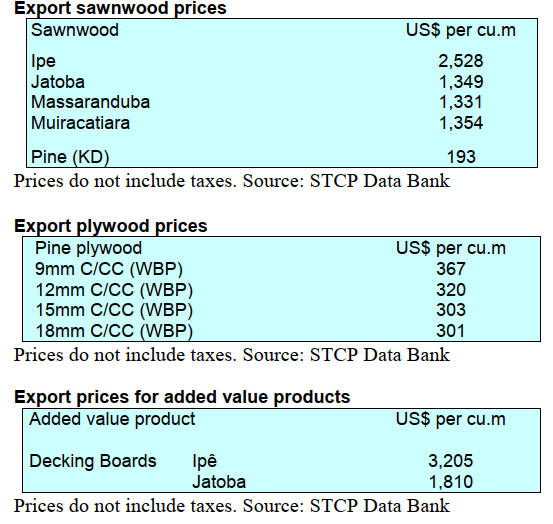
9. PERU
Exports continue to decline
Shipments of wood products in the first 5 months of 2024
totalled US$ 34.9 million, a drop of 25% compared to the
same period in 2023 (US$46.2 million) according to the
Management of Services and Extractive Industries of the
Association of Exporters (ADEX). This contraction is
partly explained by the lower orders from China and the
EU.
During these first five months France was the main export
market with a share of 16%, however, shipments were
down 43% compared to the same period in 2023. The
United States is in second place with a 15% share but for
this market shipments rose sharply. The Dominican
Republic and China were in third and fourth place with a
share of 15% each but exports to the Dominican Republic
were down.
According to figures from the ADEX Data Trade
Commercial Intelligence System, sawn wood was the most
traded wood product in wood exports in the first five
months of 2024, earning US$13.4 million, despite having
contracted 26% year on year. The second most traded
products were semi-manufactured products that reached
US$ 12.7 million but shipmentwere down 37%. Other
products were for construction (US$2.2 million), firewood
and charcoal (US$1.9 million) and furniture and its parts
(US$1.7 million).
Low rainfall and reduced humidity – fire risk rises
In the third week of August 2024 six forest fires were
reported in Ucayali. The National Meteorological and
Hydrographic Service (SENAMHI) warned that low
rainfall, reduced humidity, increases in daytime
temperatures and industrial or agricultural activities were
the main factors resulting in forest fires.
The Regional Forest and Wildlife Management of Ucayali
(GERFFS-Ucaya¬li) indicated that SERFOR reported 611
hot spots in the region between 20 August 20 and 22
August. 326 hot spots were identified in the Province of
Coronel Portillo, 114 hot spots in the Province of Padre
Abad and 171 hot spots in the Province of Atalaya.
Promoting the wood value chain
In order to promote the trade of legally harvested forest
products and support sustainable economic activities the
National Forest and Wildlife Service (SERFOR) develops
technological tools to guarantee traceability in the supply
chain.
Speaking at the plenary session of the Expert Group on
Illegal Logging and Associated Trade (EGILAT) of the
Asia-Pacific Economic Cooperation Forum (APEC) 2024,
Nelly Paredes del Castillo, Executive Director of SERFOR
is reported as saying “we focus on giving productive value
to our forests, adopting a preventive approach against
illegal logging and promoting legal trade in forest
resources from managed forests, framed in a clear and
transparent traceability mechanism that accredits the legal
origin of our timber resources, contributing to the
sustainable development of our region”
She highlighted the implementation of the 32 strategic
checkpoints of mandatory passage located on the main
transport routes in Peru, including border areas, in order to
carry out permanent control of the flow of wood.
She also highlighted the innovations in the Remote Forest
Monitoring System, in conjunction with the
Environmental and Fire Alert System, which allows for
constant monitoring and rapid response to any impact on
forest ecosystems.
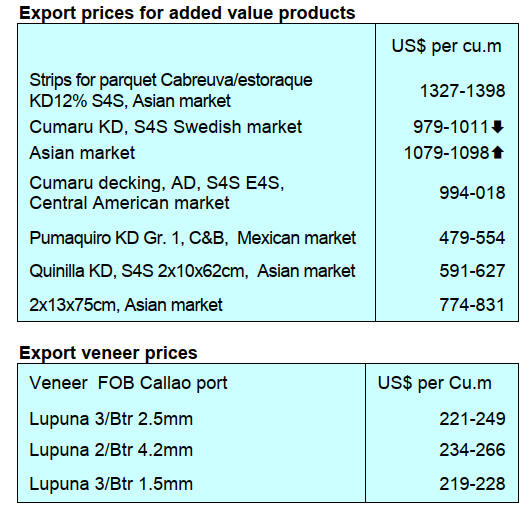 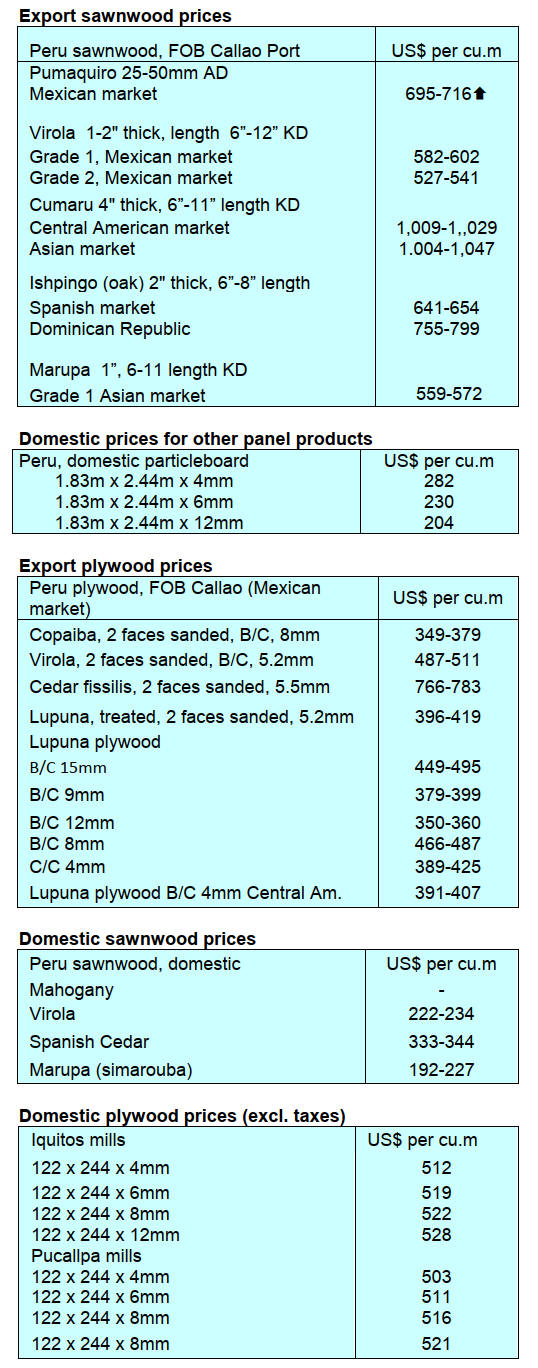
|